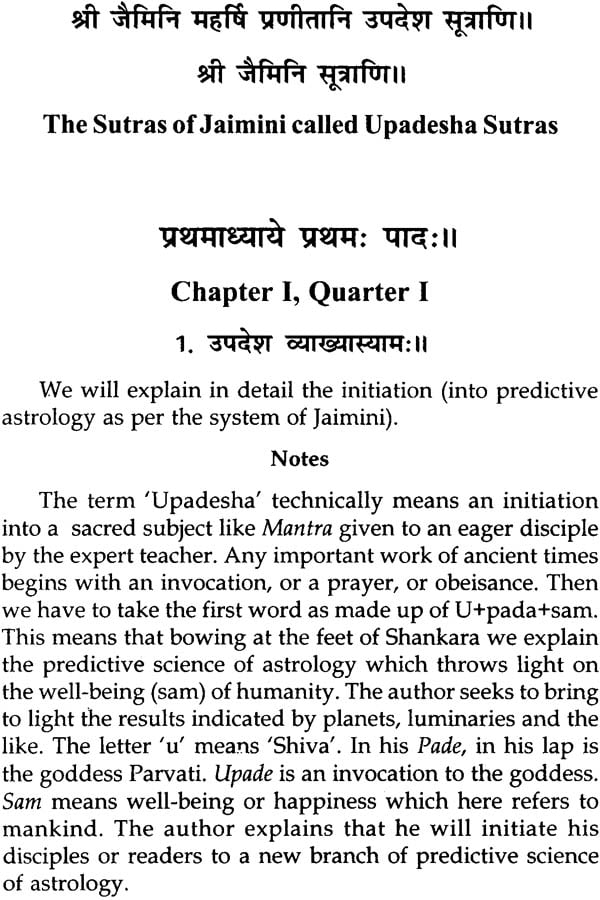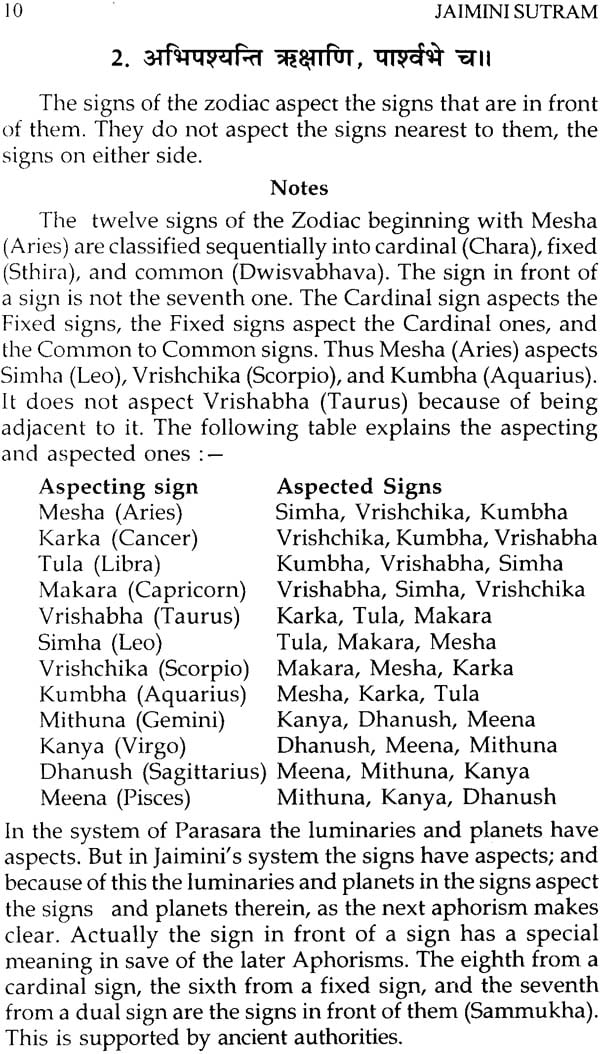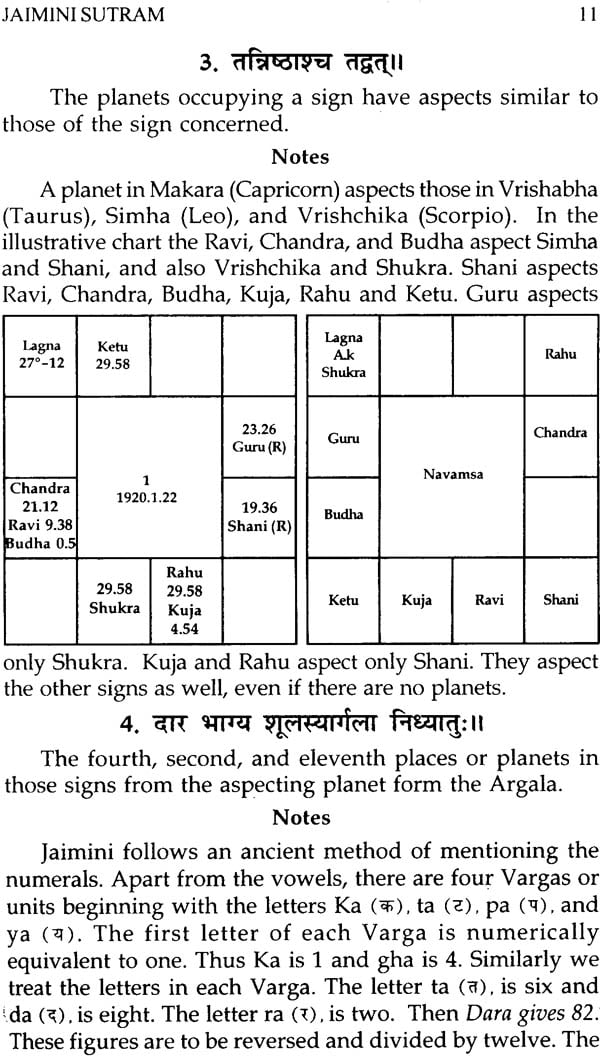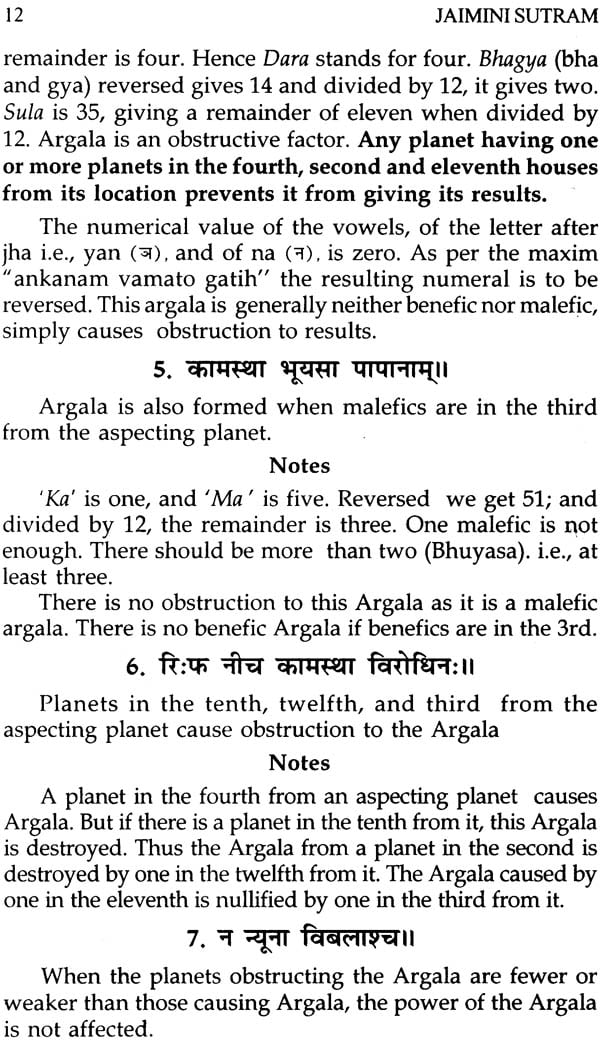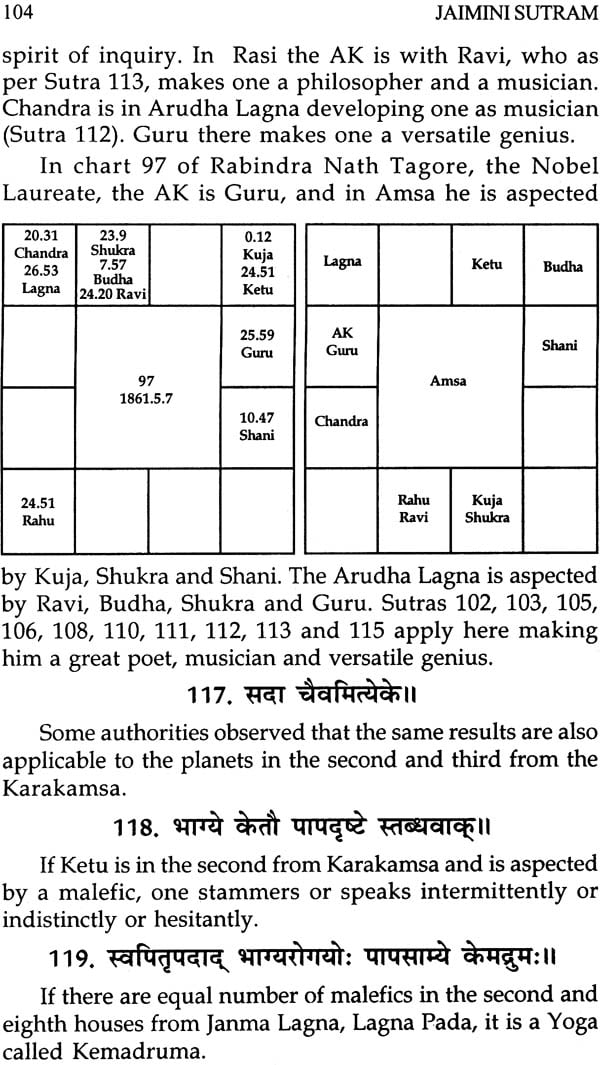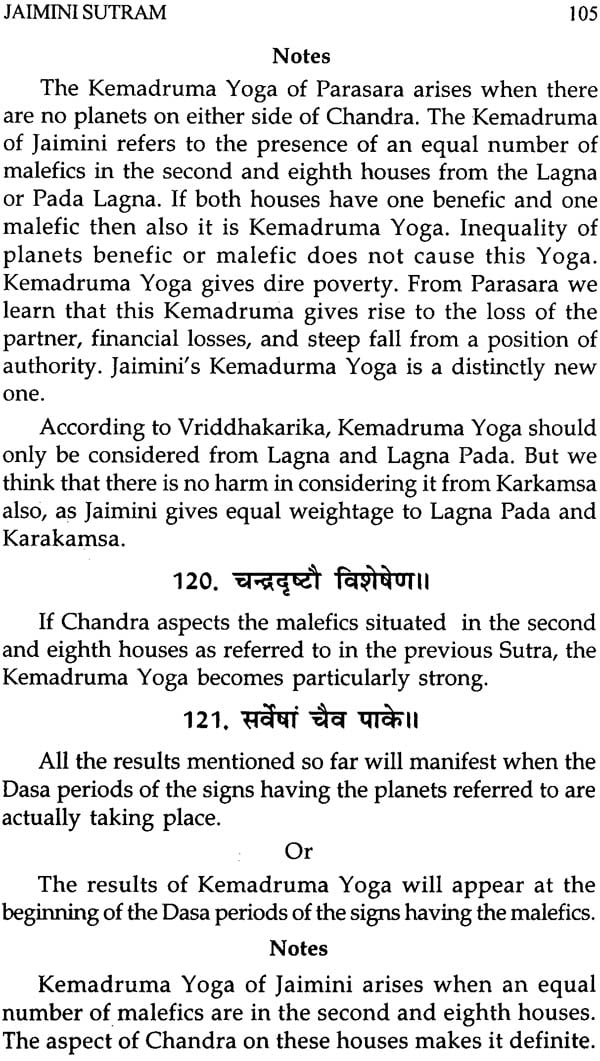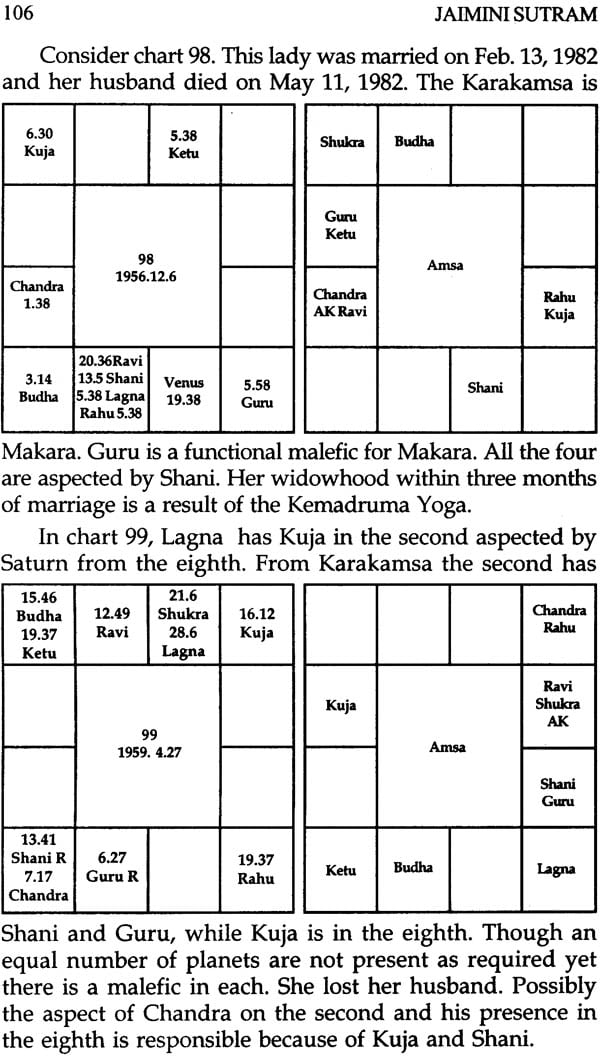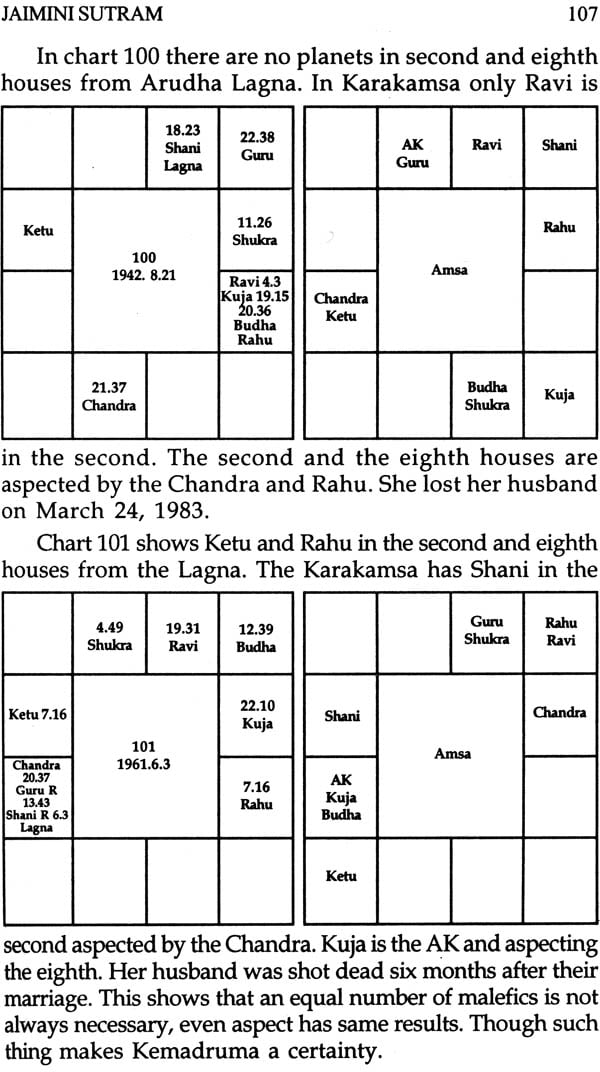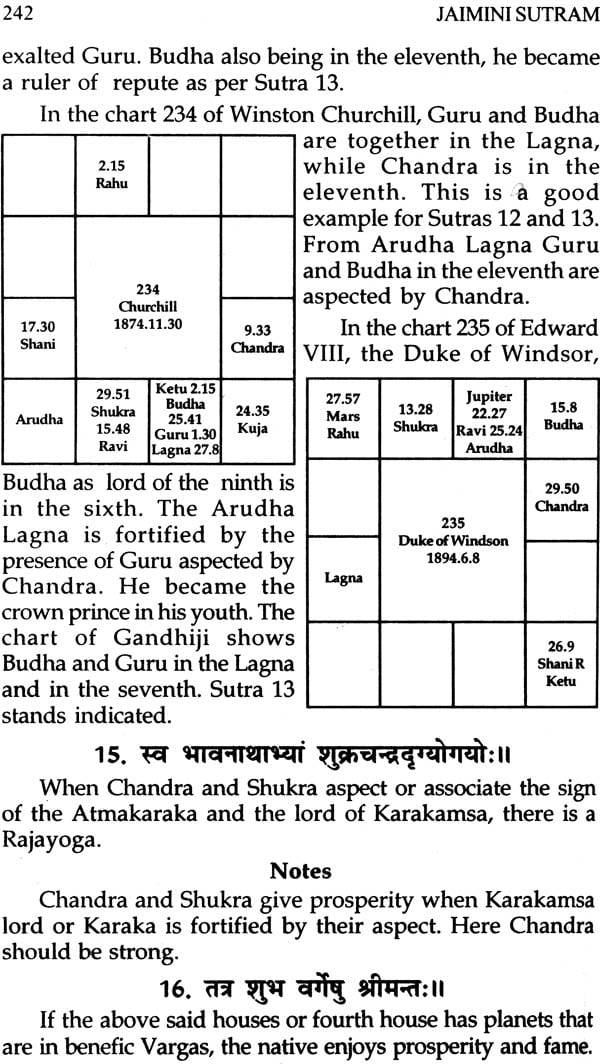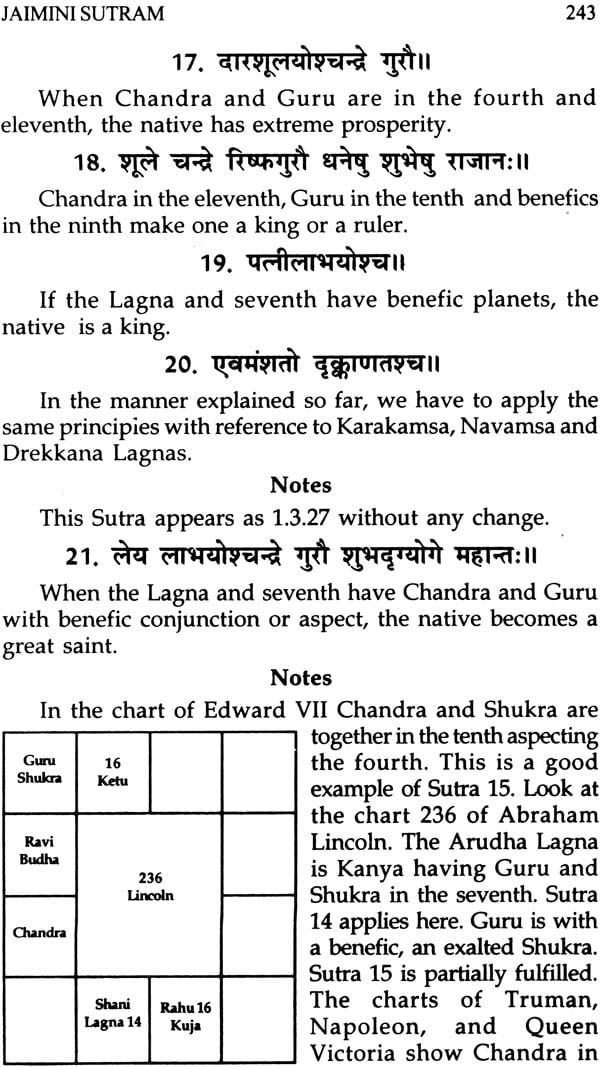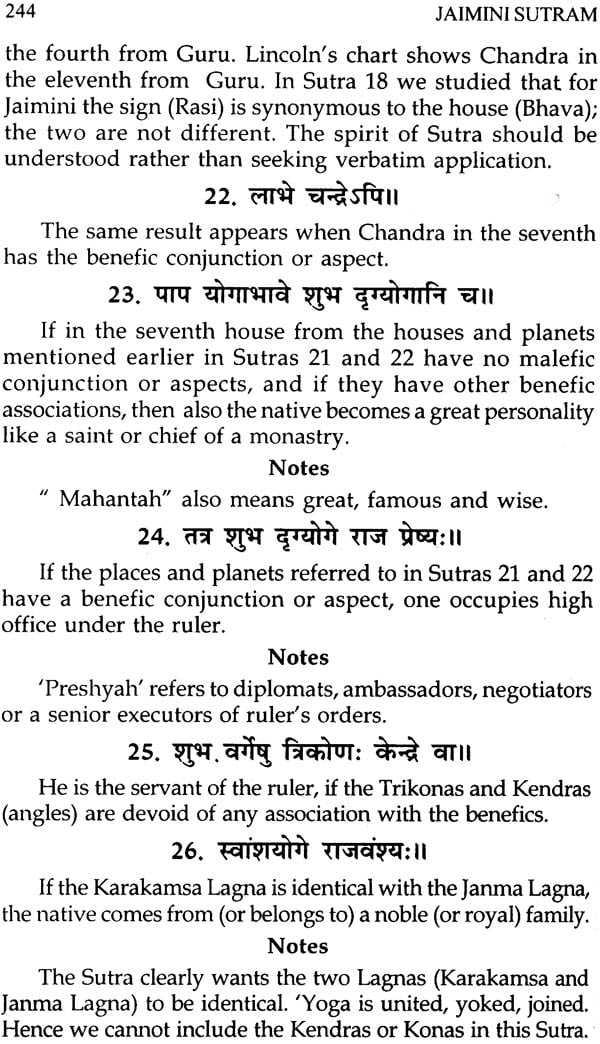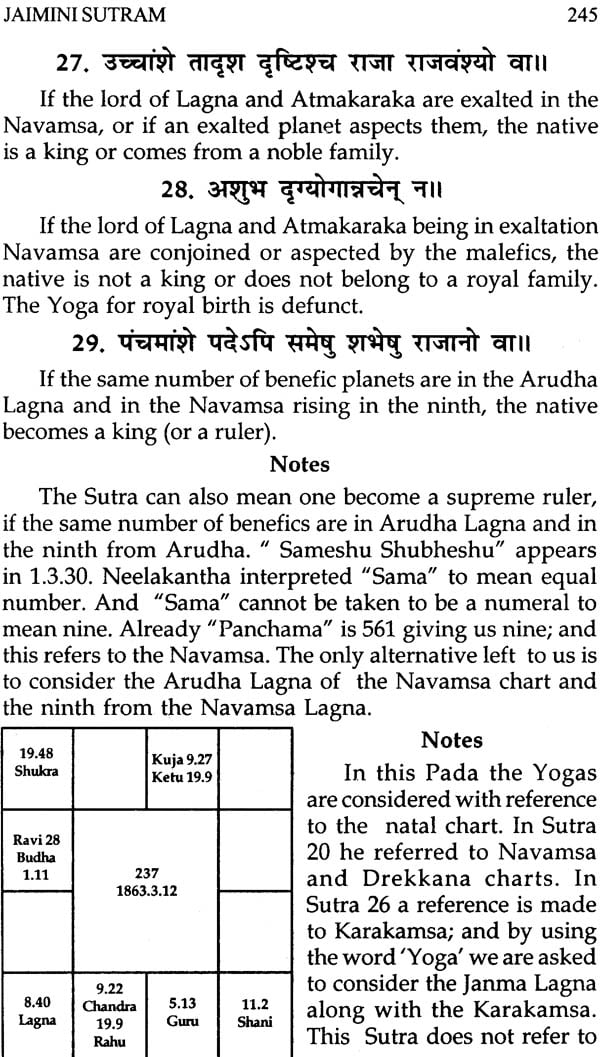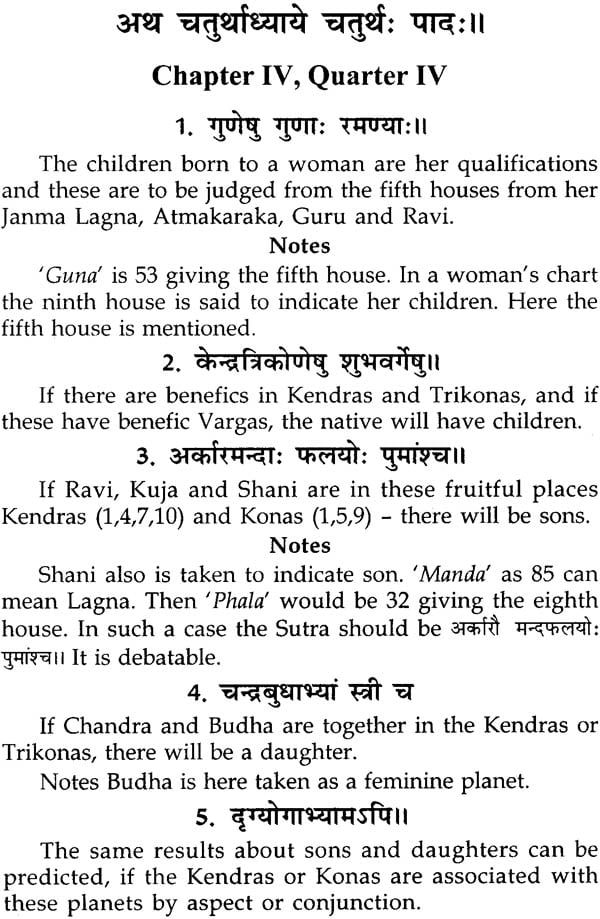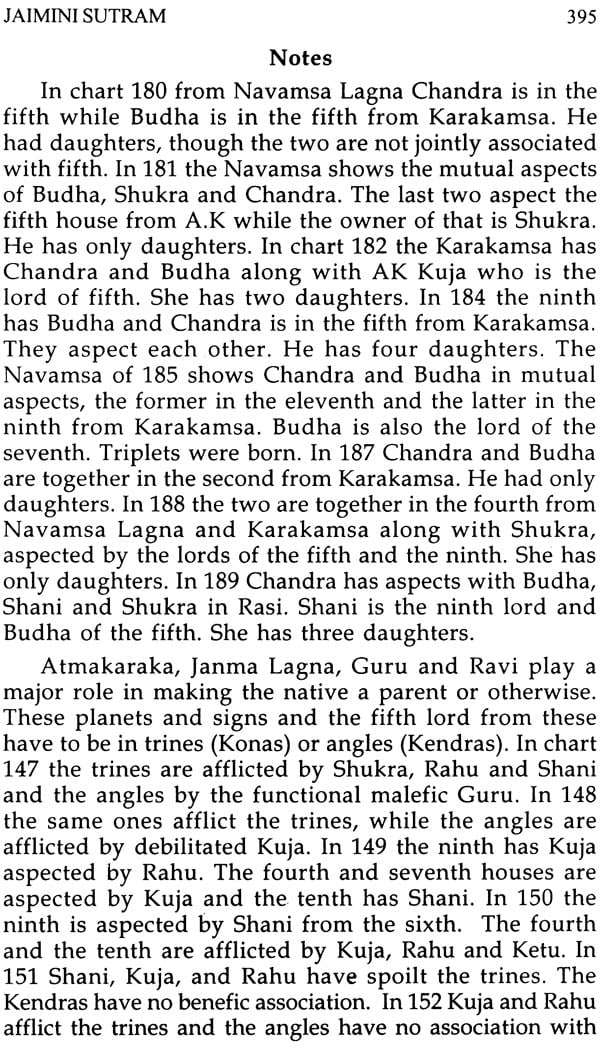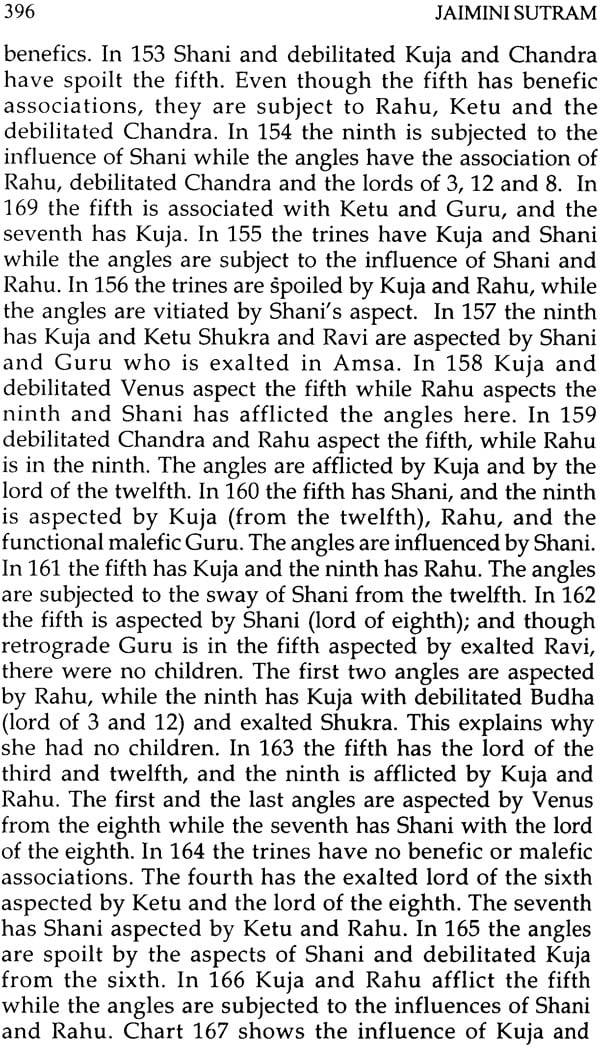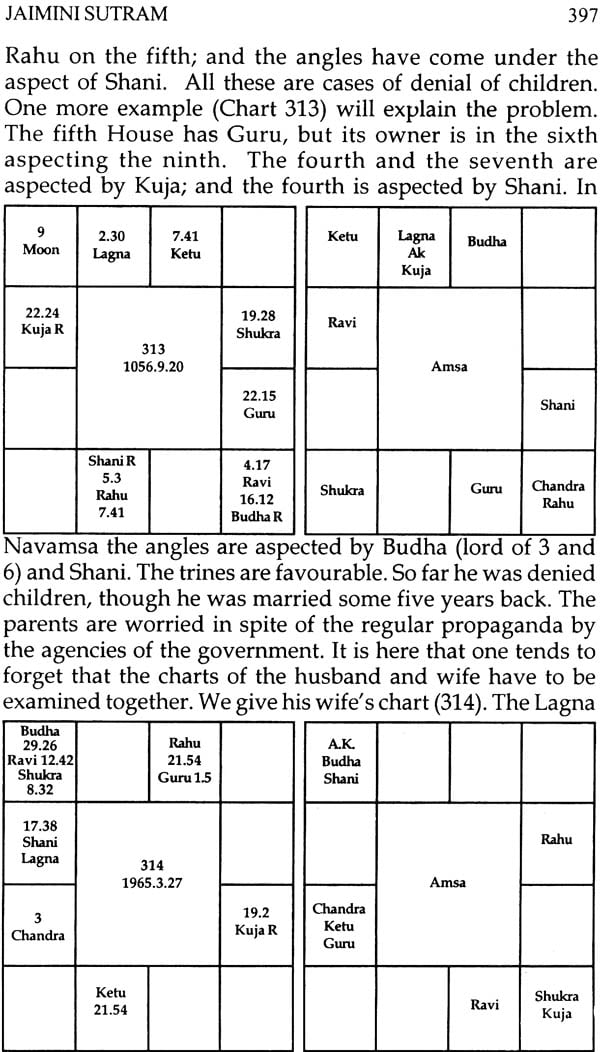
Maharshi Jaimini's Jaimini Sutram (Complete)
Book Specification
| Item Code: | IDK079 |
| Author: | Prof. P.S. Sastri |
| Publisher: | Ranjan Publications |
| Language: | English |
| Edition: | 2022 |
| ISBN: | 8188230189 |
| Pages: | 416 |
| Cover: | Paperback |
| Other Details | 8.5 inch X 9.5 inch |
| Weight | 470 gm |
Book Description
About the Book
The complete Text is in four chapters. Their Karakamsa, Arudha, Upapada and Naamsa are explained in the first chapter. The second chapter deals with longevity, diseases, profession, progeny and spouse. The third is concerned with longevity, nature and cause of death. Also there is an account of Raja yogas.
The fourth offers an elaborate account of the prenatal epoch, and the principles can be applied to the natal charts. Now, for the first time all the four chapters have been presented in a single volume. The syllable errors are corrected and the rendering follows the spirit of Maharshi Jaimini. Examples show the method of applying Jaiminian principles. This method extends, modifies and amends the interpretation of Jaimini without ignoring the spirit of the great Maharshi, a pre-Parasara authority on Astrology, enables one to know time of the events accurately.
Prof P.S. Sastri M.A. Ph.D. D. Litt born on 22nd January 1920 is an M.A. in English, Sanskrit, Telugu and Philosophy, has Ph.D. degrees in Rigveda, aesthetics and coleridge and D. Litt in Indian Philosophy.
Formerly a Professor and Head of the Department of English, University of Nagpur (Retired 1980) and was president All India Teachers Conference Varanasi (1950). He authored nearly Sixty Books on literature and Philosophy, English and Telugu. He translated Astrological classics and authored works like:-
(1) Jaimini Sutram
(2) Uttara Klamrita
(3) Brihat Jataka
(4) Rectification of Birth Time
(5) Secrets of Astakavarga
(6) Text Book of Scientific Hindu Astrology
The Sutras of Jaimini on Astrology, known as Upadesha Sutras are in four chapters. There are in all 936 Sutras (Aphorisms). Way back in 1937, the present translator and commentator was introduced to Jaimini's Sutras by persons trained on traditional lines and in 1984-85 he published his lessons in Jaimini Astrology in the Astrological Magazine Bangalore as well published in Telugu a detailed exposition of Jaimini System of Astrology.
The author of these Sutras is Maharshi Jaimini. This Jaimini is different from the other great sage Jaimini, the author of the Purva Mimansa Sutras in twelve chapters. He is also different from the Jaimini of the Brahmana-section of the Samhita, and from the others appearing in Maha-Bharata and the Puranas.
The author of these astrological Aphorisms appears to be a latter author who was acquainted with the Mantras - benign and malic; and he was well aware of the four Ashramas of Hind u society.
The main principles outlined in these Aphorisms appear in the now available text of Parasara, Brihat Parasara Hora Sastra, where chapters seven to eleven, chapters 24 to 27, and a part of the thirty-fifth chapter present the system of Jaimini. These portions appear to be inserted into Parasara's text either by Parasara himself or by some other later writer. This is clear from a comparison of the principles outlined by Jaimini with those appearing in other chapters of Parasara' s text. If the student of Parasara' s text is not careful, he will mix up the two systems and get himself in contradictions and confusions. Jaimini himself clearly stated that what he has not touched upon is to be taken from the texts of other great masters, provided the principles given in these texts do not run contrary to what he had laid down. This makes the present translator hold that Jaimini's Aphorisms are contemporaneous with or later than Parasara's text.
Jaimini' s system is unique one. The aspects mentioned here differ from the those given by the other authors. Importance is here attached to the Birth chart, Karakamsa, Arudha, Upapada, and Navamsa charts. The last four are more important. The problem of determining longevity is altogether new. The Dasas outlined are peculiar. More valuable Dasas are those designated as Chara, Sthira, Navamsa, Trikona, and Shula Dasas. These are not generally used by the students of Parasara system. The counting of the signs is not always in the clock-wise direction here. Gulika plays an important part. There is no distinction between Rasi (sign) and Bhava (house). This makes us question the authenticity of the early chapters in Parasara's text where emphasis has been on the Bhava charf. These and many other innovations make Jaimini's text a unique one. In this system the timing of events can be made within a fortnight of the event.
Nilakantha and others commented only at the first two chapters. Their commentaries are invaluable. But for these it would be difficult to grasp the intricacies of these Sutras.Texts like Vanchhanathiyam, Jataka Rajiyam and Vriddhakarikas have explained the system of Jaimini to a great extent. The Jataka Rajiyam mixed up different schools and added to our confusion at places.
The text of the Sutras presents many difficulties. Jaimini stated early in the first Pada that he refers to the zodiacal signs and houses by the numerical values of the letters of alphabet. Thus Kanya does not mean the sign Virgo, but eleven; and this can be the eleventh house or the sign Kumbha. Such expressions have been interpreted differently even by Nilakantha. Many others too have fallen into this trap.
Some Sutras were mixed up by the commentators or translators. Where we have two Sutras, some have read them as one. The problem is more complicated with regard to the last two chapters. The available texts are corrupt at many places. In the absence of authentic commentaries on these chapters, the Sutras can be corrected and are corrected in the light of the rules of Sanskrit grammar, keeping in mind the spirit of the text. Some of these Sutras repeat what has already been stated in the first two chapters; and a few Sutras reproduce the earlier one's verbatim.
The last Padas of the third chapter and the fourth chapter are concerned with the Adhana chart. This is the pre-natal epoch theory. We can arrive at the pre-natal epoch more accurately through a careful study of these Sutras.
As far as possible we have offered illustrative charts. They refer to professions, diseases and progeny. A literal interpretation does not appear to hold good. We have to interpret the text liberally taking into consideration the nature of the sign, the signs owned and occupied by the planet and other bodies associated with the planet by aspect or conjunction. Moreover, the complexity of modern life compels us to offer a very liberal interpretation of the Sutras. This is what has been achieved in this text. In the examples given we have followed Lahiri's Ayanamsa only because it is widely in use. We do not accept this Ayanamsa because it is polar, not celestial.
The present translator is deeply obliged to the pioneering work done by the late Prof. B. Suryanarain Rao, Mr. S.K. Kar and others. Discussions with these elders and others, and application of these Aphorisms to the charts enabled the present translator to develop a firm conviction in the validity of the principles laid down by Jaimini. There may have crept into the rendering some ideas which may not be acceptable to some scholars. The translator holds full responsibility for such ideas, if they are not warranted by the spirit and letter of Jaimini's text. Care has been taken to grasp the applicability in practical life of the translations and commentaries available, here and there.
The translator is glad to place on record ms obligations to M/ s Ranjan Publications for commissioning this text. They have done a splendid job in making the complete text available to the students and scholars of Astrology in a beautiful get-up. They have enabled the present translator to establish the definitive text of the Sutras. Jaimini comes before the world of Astrology blowing fresh winds.
| Chapter I, Pada 1 | 9-34 |
| Subject, Aspects, Argalas, Karakas, Method of counting, Chara Dasa, Arudha, Letters and signs; Different kinds of Lagnas, Letters indicate Rasis and houses only, The Shadvargas. | |
| Chapter I, Pada 2 | 35-109 |
| Results of Atmakaraka in various signs in Navamsa, Planets in Karakamsa, Aspects on Ravi - Rahu conjunction in Karakamsa, Gulika in Karakamsa, Aspects on Gulika in Karakamsa, Aspect on Ketu in Karakamsa, Aspects on Karakamsa by Ravi and Shukra, Resutls based on the tenth house from Karakamsa, Fourth house from Karakamsa, Ninth house from Karakamsa, Kuja and Shukra in the ninth house, Seventh house from Karakamsa, Third House, Agriculture, Twelfth House, Deity of the Native, Sixth house from Amatya Karaka, Mantrika, Chemist, Leucoderma, Leprosy, Fourth House, Karakamsa and the fifth House, Second House, Stammerings, Kemadruma Yoga, Time of Fruition. | |
| Chapter I, Pada 3 | 110-122 |
| Arudha Lagna, Prosperity, Twelfth from Arudha Lagna, Expenditure, Losses, Ailment of the Stomach, Premature aging, Prospertiy, Yogas, Raja Yogas, Conveyances, Royalty or Supreme Power, Raja Yogas, Political power, Commander of Army, Aspects as Karakamsa and Janma Lagna, Imprisonment, Eye Diseases, Symbols of Supreme Power. | |
| Chapter I, Pada 4 | 123-170 |
| Upapada, Renunciation or Loss of wife, Ravi is not a Malefic, Benefic aspects, Death of wife, Many wives, Loss of wife in old age, Wife from a noble family, Wife from a low family, Beautiful wife, Desertion of wife, Ailments to the wife, Navamsa of the seventh from Upapada, The results, General Principle of judging these, Brothers and Sisters, Teeth, Stammering, Deformity, Colours, Devotion, Legitimate or Illegitimage birth. | |
| Chapter II, Pada 1 | 171-190 |
| How to judge Longevity, Principles based as triplicity, second method, Third method, How to resolve different conclusions, Reduction of a Kakshya, Different views, Jaimini's view, Increase of a Kakshya, Yoga for death, Exception to the above, Special features about the above, Long life Strength of signs, Reduction of Kakshya and Increase of Kakshya, Yoga for death in Sthira Dasa, Yogas for Death, Death-inflicting sign. Rudra, Longevity upto Shula Rasi, Yogas for death, Maheshvara, Brahma, Longevity from Maheshvara, Planet causing death. | |
| Chapter II, Pada 2 | 191-215 |
| Father, Mother, Death of Parents, A different view, Longevity of parents, Death of wife, Deaths of others, Auspicious and inauspicious kinds of death, special features about death from the planets, Place of death, Consciousness or unconsciousness at the time of death, Funeral rites for father. | |
| Chapter II, Pada 3 | 216-222 |
| Navamsa Dasa, Sthira Dasa, Strength of signs - First source, Second source of strength, Third source of strength, Fourth source of strength, Shula Dasa, Brahma Dasa, Source of strength, Succession, Dasas in Chara Dasa, Ketu is a Benefic. | |
| Chapter II, Pada 4 | 223-235 |
| Sub periods in Chara Dasa, Dvara and Bahya Rasis, Kendra Dasa, Karaka Kendra Dasa, Kendradi Rasi Dasa, Karaka Kendra Dasa, Manduka dasa, Niryana Shula Dasa, Sequence of Dasas, Yogardha Dasa, The first Dasa, Drig Dasa, Trikona Dasa-How to count, Trikona Dasa, Nakshatra Dasa, Results, Sub-Periods, Results of Major and Minor Periods. | |
| Chapter III, Pada 1 | 236-246 |
| Maharaja Yogas, Conveyances, Rajayogas , King, Yuva Raja Yogas, Prosperity, Ruler, Great Persons, Service, Noble family, Ruler, Royal emblems. | |
| Chapter III, Pada 2 | 247-257 |
| Longevity, Kakshyas, Dvara and Bahya signs, Dasas of death, Rudra, Maheshvara and Brahma, Death. | |
| Chapter III, Pada 3 | 258-285 |
| Place of death, Death by an order of the ruler, Punya Rasis, Violent death, Untimely death, Death inside, Death from a weapon etc., Death from one's own mistakes, killed by others, Violent death, from enemies, Kidney ailment, Nature of death, Beaten to death, Snake-bite, Poison, Diarrhoea etc., Natural death, Law, Poison, Fever, Enemies, Leprosy, Cholera, Swords, Tragic end, Enemies, Drowning, Eruptions, Falling, Enemies, Urinary ailments, Poisoning, Snake-bite, Black magic, Death, Kaulakas, Diseases of water, Consumption, Excretory system, Weapons etc, Death through enemies and relatives, Quarrels, Death f parents, Death from loved one, poison, Houses of death, Fall, Consciousness, Digestive system, Enemies, Accidents, Diseases, Limbs, Strength of signs, Sub periods, Longevity and death of mother, Houses of death. | |
| Chapter III, Pada 4 | 286-326 |
| Arudha, Upagrahas, Adhana Lagna, Father, Conception, Fertilization, Miscarriage, Semen and ovum, Varnada Lagna, Conception, Foetus, Sperm, Constitution of the child, Sex of the child, Mother's diseases, Colour of the child, Principles, Brith of child, Number of children, Twins, Deformed organs. | |
| Chapter IV, Pada 1 | 327-338 |
| Deha, Limbs of the foetus, Growth of limbs, Illegal children, Caste, Qualification, Female children, Happy child, Unhappy child, Pious, Scholar, Wise, Judgement of Pranapada and Adhana Lagnas. | |
| Chapter IV, Pada 2 | 339-348 |
| Marakas, Bhava aspects, Deformed child, Twins, Time of delivery, Time measure, Defects of child, Child abandoned, Janma Lagna, Other Principles. | |
| Chapter IV, Pada 3 | 349-393 |
| Sex of child, Time of birth, Longitude of Lagna from Adhana, Colour and Sex, Varnada Dasa, Complexion, Pranapada, Ghatika Lagna, Bhava Lagna, Vighati Lagna, Sex, Time of Delivery, Male or female, Hora Lagna, Navamsa of Hora Lagna, Destruction of husband, Appearance, Nasty habits, death, passionate wife, Character of woman, Principles, Qualified woman, Female horoscope from Navamsa, Judgement from Varnada Lagna, Lords of gestation, Judgement from lords, Deformity of foetus, Appearance, Dificult delivery, Odd and even signs, Determination of sex. | |
| Chapter IV, Pada 4 | 394-413 |
| Sons and daughters, Sex of children, Menses and widowhood, Copulation, Manner of copulation, Place of copulation, Immoral sex, Possibility of birth, Possibility of conception, Houses of children, Significators of children. |
